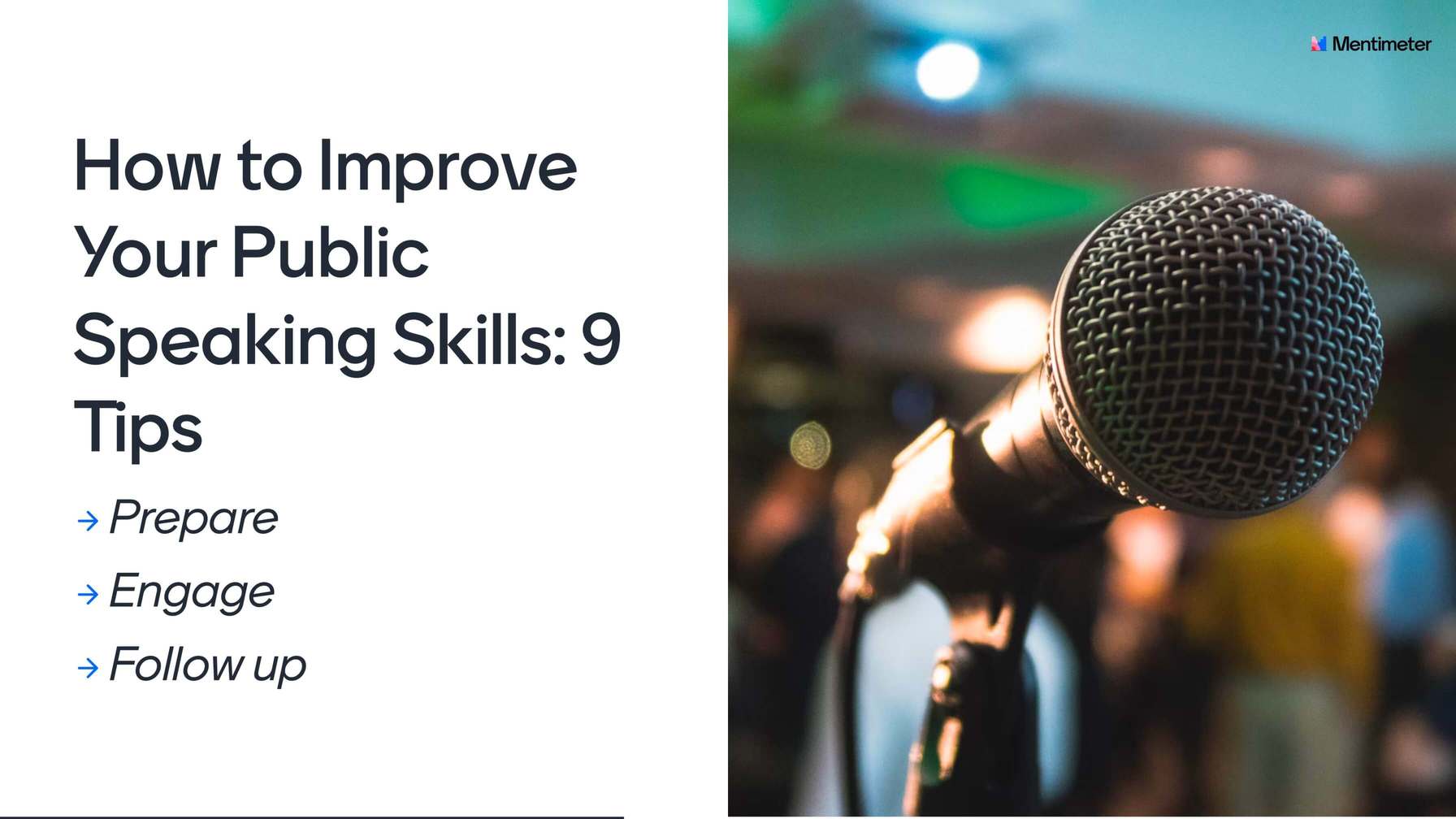Public speaking is a common - and dreaded - activity in the modern business world. Yet, no one is inherently a super presenter. Speaking confidently in front of an audience is a skill that, like anything else, can be learned. In this three-part post, we will explore ways in which you can overcome your fears of public speaking and become a more confident presenter.
Being nervous or anxious during a live presentation is a completely normal and natural reaction. We are all social creatures, and standing in front of a full audience can stimulate feelings of extreme excitement or anxiety. How often have you watched someone present and marveled out how confidently they carried themselves or how strong their oratory, only to find out they were a nervous wreck just moments before stepping on stage?
So what can we do to make this easier on the presenter? What if we could remove some of that pressure from the presenter’s shoulders and let the audience do some of the work? We here at Mentimeter are all about making the art of presenting an easy, inclusive, and engaging process. What do we mean by all this? Well, let’s dive in!
- Begin well in advance
- Know your audience
- Know your tech
- Interact early & often
- Be aware of your pace and timing
- Let Mentimeter handle the awkward silences
- Feedback is your best friend
- Record & rewatch, again and again
- Take every chance you can to practice
Prepare - before your presentation
The preparation stage is where it all begins. This is where you will, not only, create your notes and slides, but also rehearse what you are going to say and, perhaps, even contemplate some feedback or questions you may receive. Once on stage, you will feel less anxious and more confident the more you have prepared. It will then be about repeating yourself.
1. Begin well in advance
Your presentation does not start the minute you take the stage - it begins days, weeks, or even months beforehand. Clear out time in your calendar to prepare your topic, notes, and slides. What will you be talking about? What is your core message? What presentation tools will you be using?
The more time you have to prepare and rehearse, the easier it will be for you to deliver on the day. This also gives you more time to get feedback from friends and colleagues that will help you make tweaks and adjustments.
2. Know your audience
This is an important, yet often overlooked aspect of a successful presentation. Who will you be talking to? What do they already know? What do they want to know? Considering these questions before you even start planning your presentation will ensure that what you discuss will be relevant and pertinent to everyone in attendance.
Does your audience know all the abbreviations that you might use? If unsure, always aim for clarity rather than complexity. Surveying your audience in advance and collecting information about your crowd is the optimum way of doing this. You can even use the results in your live presentation to save time and to use an audience's feedback and response to kickstart your presentation!
3. Know your tech
Presenting in front of an audience often involves more than just a script and slide deck - you also need to understand how to set up for online and hybrid presentations. If you are hosting a presentation online, make sure to prepare your tech set up well in advance, and perhaps do a test run with a friend or colleague before your presentation to make sure everything looks and sounds good.
If you are using video conferencing software, such as Zoom, Google Meet, or Microsoft Teams, make sure your mic works well, that you know how to screen share, and that you can troubleshoot any basic problem that your audience may encounter.
Preparation is the key to handling many of the worries that you may have when speaking in front of an audience. If you do feel anxious before going on stage, you will at least know that you have done everything possible to prepare fully.
Engage - during your presentation
Engaging your audience is a crucial aspect of successful presentations, so ask yourself, “How can I involve my audience as much as possible?” This is important in several different ways; maintaining a high level of engagement means that your audience is more likely to listen to you and retain the info you’ve shared. In this section, we will go through some tips that will keep your audience engaged throughout your talk.
4. Interact early & often
A great way to grab ahold of an audience’s attention early on is to start with an icebreaker. It could be a serious open-ended question, a poll relevant to your chosen topic of discussion, or something fun and lighthearted. Starting off your presentation with a strong icebreaker will help create a platform upon which you can build upon.

Where Are You From?
5. Be aware of your pace and timing
Finding the right talking pace can be a bit tricky- speak too fast and you might come off as nervous, go too slow and everyone’s minds will begin to wander. The trick here is to vary the speed and rhythm throughout the presentation.
If you want to grab attention and energize the audience, speak a little faster. When you want to deliver information or background, find a comfortable pace. When you want to drive your point home - slow down. By varying your speed your presentation will become more dynamic and less stagnant, thus helping to maintain concentration and engagement.
6. Let Mentimeter handle the awkward silences
We all know how uncomfortable awkward silences can be. And while a well-placed pause can help you drive your message home, a long, drawn-out silence will hinder it. But with Mentimeter - you can avoid that and take the pressure off of your presentation. Let the audience do the work!
Interactive Word Clouds, Open-ended questions, and live polls will eliminate any awkward silence and make these moments a time for reflection and deliberation. There are of course many other ways in which you can create engagement, such as bringing in questions from the audience or hosting a quiz, but remember that a little goes a long way!
By considering the importance of early and frequent engagement, you will understand how you can captivate your audience from the very start and what you can do to make sure those attention levels remain high throughout your presentation. In our third section, we will look at what happens after your presentation.
Follow up - after your presentation
This third and final section covers an important aspect of building confidence; what happens after the presentation? In order to continuously improve, make time to reflect upon and scrutinize your performance. How did it go? What worked? What didn’t? What will you do differently next time? It is especially helpful if you can speak with someone who was in the audience.
7. Feedback is your best friend
While it can be tough to receive constructive feedback, it is the best way to highlight what you need to focus on in order to improve. Ask a friend, a colleague, or even someone in the audience to take a few minutes after your presentation to share their opinions. A post-presentation survey that can be sent to every member of the audience can help gather a wide variety of insights from different perspectives.
8. Record & rewatch, again and again
Make it a habit to record all your presentations. Even though it might seem a bit awkward to hear and see yourself at first, watching a recording of your talk will provide you with unique insights that you will not naturally gather from your own point of view. By seeing your presentation from the audience's perspective, you get a front-row view of yourself. If you tend to forget about recording your talks, have a friend or colleague do it for you. That way, you can fully focus on your presentations without worrying about any technical setups.
9. Take every chance you can to practice
Remember that public speaking is a skill that can be learned. And learning takes practice and patience, which is why you should take every chance you can to present. Does your team need someone to host your next meeting? Maybe host a dinner party quiz with your friends?
Take every opportunity and see it as a form of practice! No matter how good or bad, every talk you do will give you an opportunity to develop and learn. No matter if you believe that practice makes permanent or if it makes perfect, you will learn so much from doing that these presenting skills will become perfectly permanent.
Presenting need not be daunting
Presenting is by no means easy, but as we have seen there are countless things we can do to make it easier and less stressful. Technology plays a vital role in both work and education and aims to make our lives a little bit more straightforward. So why not use every tool at your disposal when presenting? Mentimeter has been designed specifically to help reduce presenter stress, eliminate those dreaded awkward silences, and bring the audience into the fold like never before. And if you want an even more comprehensive deep dive into presenting to an audience, you can check out our free public speaking course!


![160+ general knowledge quiz questions for any occasion [2024]](https://images.ctfassets.net/rvt0uslu5yqp/7fDPDXbVBGuX8Ai9V5U3qP/25d81ca5e0acd67a4376ca3166bb66d7/quiz-questions-hero.png?fm=webp&w=3840&q=75)
